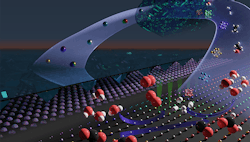Machine Learning Speeds Nanomaterial Discoveries
Nanoparticles have broad applications as alternative materials to shrinking natural resources. However, nanochemistry’s vast compositional and structural tunability limits researchers’ ability to efficiently identify new materials to expand their use.
To speed up materials discovery and guide the synthesis of novel nanomaterials, researchers at Northwestern University, Evanston, Ill., and the Toyota Research Institute (TRI), Los Altos, Calif., turned to applied machine learning (ML). An algorithm combs a defined dataset, called a “megalibrary,” to accurately predict new structures and catalysts critical to green energy and waste reduction processes.
ML applications well suit tackling the complexity of defining and mining the massive “materials genome,” but the difficulty in creating datasets to train algorithms hinders their use. Combining a megalibrary with ML may finally eradicate that problem, says Chad Mirkin, a nanotechnology expert and professor at the university’s McCormick School of Engineering.
“This AI-driven approach will impact most industries that would benefit from the discovery of new materials with enhanced properties and functions, and it is already playing a critical role in many sectors. For example, the megalibrary platform is an efficient and powerful way to sift through the materials genome and find the best catalysts for a variety of chemical reactions,” notes Mirkin.
Megalibraries can house millions of nanostructures, each with a slightly distinct shape, structure and composition. Current libraries consist of over 220 million particles in a 2-cm2 chip. Building smaller subsets of nanoparticles in the form of megalibraries will bring researchers closer to completing a full map of a materials genome, the team believes.
In a study highlighted in an article in the journal Science Advances, the team compiled previously generated megalibrary structural data consisting of nanoparticles with complex compositions, structures, sizes and morphologies. They used these data to train the model and asked it to predict compositions that would result in a certain structural feature. With little knowledge of chemistry or physics, using only the training data, the model accurately predicted complicated structures that have never existed on earth.
“We asked the model to tell us what mixtures of up to seven elements would make something that hasn’t been made before,” explains Mirkin. “The machine predicted 19 possibilities and, after testing each experimentally, we found 18 of the predictions were correct.”
The team is developing a number of screening technologies that enable extracting more and different types of information about a megalibrary at an even faster pace. “These approaches enable the high-throughput characterization of the catalytic, structural, and optical properties of the millions of nanoparticles in the array at the single-particle level,” he says.
Targeted properties also will become more complex. Mirkin elaborates: “We aim to identify and understand how a nanomaterial’s structure affects its functionality. This requires collecting crystallographic information and functional metrics that can be used to develop our predictions, and disentangling such relationships in particles of ever increasing structural and compositional complexity is no easy task. But, the ability to target not only specific structural motifs, but also particular functional parameters directly for specific applications, represents a significant advance.”
“We have funded development relationships with pharmaceutical companies, chemical companies, companies in the clean energy and oil and gas sectors, and government research laboratories that are interested in using the approach to explore routes to a wide range of materials that are aligned with their interests,” reveals Mirkin.
In addition, a startup company called Stoicheia, spun out of Northwestern last year, is commercializing the megalibrary technology. “Stoicheia is utilizing this technology to discover new materials independently and in collaboration with industrial partners. It is generating massive, high-quality structure-function datasets that will be the basis of an AI-driven materials discovery factory that will operate at an unprecedented rate,” concludes Mirkin.
